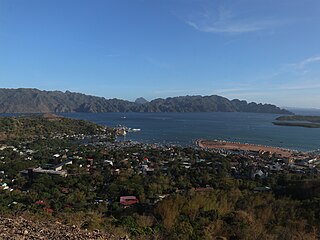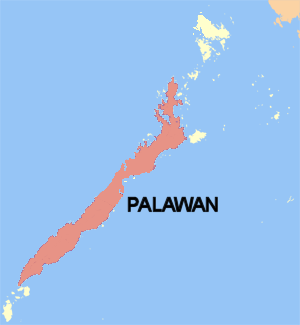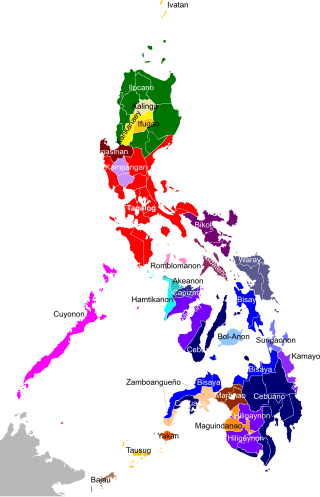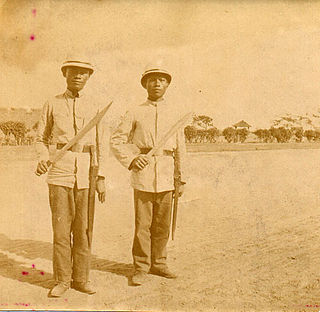
The Visayas, or the Visayan Islands, are one of the three principal geographical divisions of the Philippines, along with Luzon and Mindanao. Located in the central part of the archipelago, it consists of several islands, primarily surrounding the Visayan Sea, although the Visayas are also considered the northeast extremity of the entire Sulu Sea. Its inhabitants are predominantly the Visayan peoples.

Palawan, officially the Province of Palawan, is an archipelagic province of the Philippines that is located in the region of Mimaropa. It is the largest province in the country in terms of total area of 14,649.73 km2 (5,656.29 sq mi). The capital and largest city is Puerto Princesa which is geographically grouped with but administered independently from the province. Palawan is known as the Philippines' Last Frontier and as the Philippines' Best Island.

Busuanga, officially the Municipality of Busuanga, is a 3rd class municipality in the province of Palawan, Philippines. According to the 2020 census, it has a population of 25,617 people.

Coron, officially the Municipality of Coron, is a 1st class municipality in the province of Palawan, Philippines. According to the 2020 census, it has a population of 65,855 people.

El Nido, officially the Municipality of El Nido, is a 1st class municipality in the province of Palawan, Philippines. According to the 2020 census, it has a population of 50,494 people.

Palawan is the largest island of the province of Palawan in the Philippines and fifth-largest by area and tenth-most populous island of the country, with a total population of 994,101 as of 2020 census. The northwest coast of the island is along the Palawan Passage in the eastern South China Sea, while the southeast coast forms part of the northern limit of the Sulu Sea. Much of the island remains traditional and is considered by some as under-developed. Abundant wildlife, jungle mountains, and some white sandy beaches attract many tourists, as well as international companies looking for development opportunities.
Ratagnon is a regional language spoken by the Ratagnon people, an indigenous group from Occidental Mindoro. It is a part of the Bisayan language family and is closely related to other Philippine languages. Its speakers are shifting to Tagalog. In 2000, there were only two to five speakers of the language. However, in 2010 Ethnologue had reported there were 310 new speakers.
Cuyonon is a regional Bisayan language spoken on the coast of Palawan and the Cuyo Islands in the Philippines. Cuyonon had been the lingua franca of the province of Palawan until recently when migration flow into the region rapidly increased. Forty-three percent of the total population of Palawan during the late 1980s spoke and used Cuyonon as a language. Later studies showed a significant decrease in the number of speakers due to an increase of Tagalog-speaking immigrants from Luzon.

Datu is a title which denotes the rulers of numerous Indigenous peoples throughout the Philippine archipelago. The title is still used today, though not as much as early Philippine history. It is a cognate of ratu in several other Austronesian languages.

Culion, officially the Municipality of Culion, is a 3rd class municipality in the province of Palawan, Philippines. According to the 2020 census, it has a population of 23,213 people.

Cagayancillo, officially the Municipality of Cagayancillo, is a 6th class municipality in the province of Palawan, Philippines. According to the 2020 census, it has a population of 6,884 people.

Cuyo, officially the Municipality of Cuyo, is a 4th class municipality in the province of Palawan, Philippines. According to the 2020 census, it has a population of 23,489 people.

Taytay, officially the Municipality of Taytay, is a 1st class municipality in the province of Palawan, Philippines. According to the 2020 census, it has a population of 83,357 people.

The Philippines is inhabited by more than 182 ethnolinguistic groups, many of which are classified as "Indigenous Peoples" under the country's Indigenous Peoples' Rights Act of 1997. Traditionally-Muslim peoples from the southernmost island group of Mindanao are usually categorized together as Moro peoples, whether they are classified as Indigenous peoples or not. About 142 are classified as non-Muslim Indigenous people groups, and about 19 ethnolinguistic groups are classified as neither Indigenous nor Moro. Various migrant groups have also had a significant presence throughout the country's history.
The Hiligaynon people, often referred to as Ilonggo people or Panayan people, are the second largest subgroup of the larger Visayan ethnic group, whose primary language is Hiligaynon, an Austronesian language of the Visayan branch native to Panay, Guimaras, and Negros. They originated in the province of Iloilo, on the island of Panay, in the region of Western Visayas. Over the years, inter-migrations and intra-migrations have contributed to the diaspora of the Hiligaynon to different parts of the Philippines. Today, the Hiligaynon, apart from the province of Iloilo, also form the majority in the provinces of Guimaras, Negros Occidental, Capiz, South Cotabato, Sultan Kudarat, and Cotabato Province. Hiligaynon is also spoken in some parts of Sarangani Province particulary in the Municipality of Malungon.

Palawan, the largest province in the Philippines, is home to several indigenous ethnolinguistic groups namely, the Kagayanen, Tagbanwa, Palawano, Taaw't Bato, Molbog, and Batak tribes. They live in remote villages in the mountains and coastal areas.
The Karay-a are a Visayan ethnic group native to the islands of Panay and Palawan in the Philippines. They speak the Karay-a language.

The Cebuano people are the largest subgroup of the larger ethnolinguistic group Visayans, who constitute the largest Filipino ethnolinguistic group in the country. They originated in the province of Cebu in the region of Central Visayas, but then later spread out to other places in the Philippines, such as Siquijor, Bohol, Negros Oriental, southwestern Leyte, western Samar, Masbate, and large parts of Mindanao. It may also refer to the ethnic group who speak the same language as their native tongue in different parts of the archipelago. The term Cebuano also refers to the demonym of permanent residents in Cebu island regardless of ethnicity.
The Aklanon people are the ethnolinguistic group who lived in the province of Aklan. They are part of the wider Bisaya ethnolinguistic group, who constitute the largest Filipino ethnolinguistic group.

The Apostolic Vicariate of Taytay is a Latin Catholic pre-diocesan missionary jurisdiction in the island of Palawan in the Philippines.













